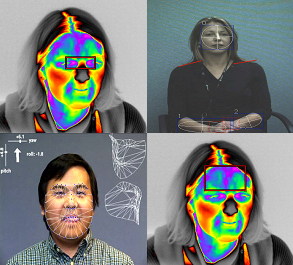Biodefense refers to measures to restore biosecurity to a group of organisms who are, or may be, subject to biological threats or infectious diseases. Biodefense is frequently discussed in the context of biowar or bioterrorism, and is generally considered a military or emergency response term.

The United States Department of Homeland Security (DHS) is the U.S. federal executive department responsible for public security, roughly comparable to the interior or home ministries of other countries. Its stated missions involve anti-terrorism, border security, immigration and customs, cyber security, and disaster prevention and management.

The National Cyber Security Division (NCSD) is a division of the Office of Cyber Security & Communications, within the United States Department of Homeland Security's Cybersecurity and Infrastructure Security Agency. Formed from the Critical Infrastructure Assurance Office, the National Infrastructure Protection Center, the Federal Computer Incident Response Center, and the National Communications System, NCSD opened on June 6, 2003. The NCSD mission is to collaborate with the private sector, government, military, and intelligence stakeholders to conduct risk assessments and mitigate vulnerabilities and threats to information technology assets and activities affecting the operation of the civilian government and private sector critical cyber infrastructures. NCSD also provides cyber threat and vulnerability analysis, early warning, and incident response assistance for public and private sector constituents. NCSD carries out the majority of DHS’ responsibilities under the Comprehensive National Cybersecurity Initiative. The FY 2011 budget request for NCSD is $378.744 million and includes 342 federal positions. The current director of the NCSD is John Streufert, former chief information security officer (CISO) for the United States Department of State, who assumed the position in January 2012.

The Homeland Security Act (HSA) of 2002, was introduced in the aftermath of the September 11 attacks and subsequent mailings of anthrax spores. The HSA was cosponsored by 118 members of Congress. The act passed the U.S. Senate by a vote of 90–9, with one Senator not voting. It was signed into law by President George W. Bush in November 2002.
Homeland Security Advanced Research Projects Agency (HSARPA) is a part of the Science and Technology Directorate at the United States Department of Homeland Security. Much like DARPA in the Department of Defense, HSARPA is tasked with advanced projects to advance the technology needed to protect the US. Some of the chief beneficiaries of HSARPA are the Customs and Border Protection, and the Office of Intelligence and Analysis.

The Border and Maritime Security Division (BMD) is a division of the Science and Technology Directorate of the United States Department of Homeland Security. Within the Homeland Security Advanced Research Projects Agency, BMD develops tools and technologies that improve the security of the United States's land borders and waterways.

The Project Bioshield Act was an act passed by the United States Congress in 2004 calling for $5 billion for purchasing vaccines that would be used in the event of a bioterrorist attack. This was a ten-year program to acquire medical countermeasures to biological, chemical, radiological, and nuclear agents for civilian use. A key element of the Act was to allow stockpiling and distribution of vaccines which had not been tested for safety or efficacy in humans, due to ethical concerns. Efficacy of such agents cannot be directly tested in humans without also exposing humans to the chemical, biological, or radioactive threat being treated, so testing follows the FDA Animal Rule for pivotal animal efficacy.

Project Hostile Intent is an ongoing project of the United States Department of Homeland Security, Human Factors Division. It has been renamed to Future Attribute Screening Technology. This project comes under the Social and Behavioral Research (SBR) Program, one of the three broad program areas within the Science and Technology (S&T) Directorate of the Department of Homeland Security (DHS) that "sponsors research to inform, develop, and test tools and methodologies to assess terrorist threats, understand terrorism, and improve national security".

The Explosives Division (EXD) is a division of the Science and Technology Directorate of the United States Department of Homeland Security. Within the Homeland Security Advanced Research Projects Agency, EXD develops technologies needed to detect, interdict, and lessen the effect of non-nuclear explosives used by terrorists against mass transit, civil aviation, and critical infrastructure.
According to the DHS S&T website, the Command, Control, and Interoperability Division was a unit of the DHS Science and Technology Directorate which "develops interoperable communication standards and protocols for emergency responders, cyber security tools for protecting the integrity of the Internet, and automated capabilities to recognize and analyze potential threats."

The Human Factors and Behavioral Sciences Division (HFD) is a division of the Science and Technology Directorate of the United States Department of Homeland Security. Within the Homeland Security Advanced Research Projects Agency, HFD applies social and behavioral sciences to improve detection, analysis, and understanding and response to homeland security threats.

The Infrastructure Protection and Disaster Management Division (IDD) is a division of the Science and Technology Directorate of the United States Department of Homeland Security. Within the Homeland Security Advanced Research Projects Agency, IDD develops technologies to improve and increase the United States' strategic preparedness response to natural and man-made threats through situational awareness, emergency response capabilities, and critical infrastructure protection.

The U.S. Army Edgewood Chemical Biological Center (ECBC) is the United States's principal research and development resource for non-medical chemical and biological (CB) defense. As a critical national asset in the CB defense community, ECBC supports all phases of the acquisition life-cycle ― from basic and applied research through technology development, engineering design, equipment evaluation, product support, sustainment, field operations and demilitarization ― to address its customers’ unique requirements.

The Under Secretary of Homeland Security for Science and Technology is a high level civilian official in the United States Department of Homeland Security. The Under Secretary, as head of the Science and Technology Directorate at DHS, is the principal staff assistant and adviser to both the Secretary of Homeland Security and the Deputy Secretary of Homeland Security for all DHS technological research.

The Command, Control and Interoperability Division is a bureau of the United States Department of Homeland Security's Science and Technology Directorate, run by Dr. David Boyd. This division is responsible for creating informative resources(including standards, frameworks, tools, and technologies) that strengthen communications interoperability, improve Internet security, and integrity and accelerate the development of automated capabilities to help identify potential threats to the U.S.
National Urban Security Technology Laboratory is a United States government-owned, government-operated laboratory, part of the Department of Homeland Security (DHS) Science & Technology Directorate. It is located in the Federal Office Building at 201 Varick Street in the Hudson Square neighborhood, Manhattan, New York.

Penrose "Parney" C. Albright is a physicist and weapons scientist known for his work with the U.S. Government, think tanks and National Laboratories, and government contractors. Since November 1, 2014, he has been the president and CEO of HRL Laboratories, a research firm jointly owned by Boeing and General Motors. Until December 2013 he served as the director of Lawrence Livermore National Laboratory, and, in 2014, he served as a senior advisor in the Office of the Director of National Intelligence.

The Cyber Security Division (CSD) is a division of the Science and Technology Directorate of the United States Department of Homeland Security (DHS). Within the Homeland Security Advanced Research Projects Agency, CSD develops technologies to enhance the security and resilience of the United States' critical information infrastructure from acts of terrorism. S&T supports DHS component operational and critical infrastructure protections, including the finance, energy, and public utility sectors, as well as the first responder community.

The National Cybersecurity and Critical Infrastructure Protection Act of 2013 is a bill that would amend the Homeland Security Act of 2002 to require the Secretary of the Department of Homeland Security (DHS) to conduct cybersecurity activities on behalf of the federal government and would codify the role of DHS in preventing and responding to cybersecurity incidents involving the Information Technology (IT) systems of federal civilian agencies and critical infrastructure in the United States.
Anne Hultgren was the Branch Chief for research and development in the Chemical and Biological Defense Division of the Science and Technology Directorate of the United States Department of Homeland Security. She worked in the department from 2005 to 2015. There she helped to develop and test the "Detect-to-Protect" biological detection program. As of February 2015 she became the executive director of the Arnold and Mabel Beckman Foundation.






